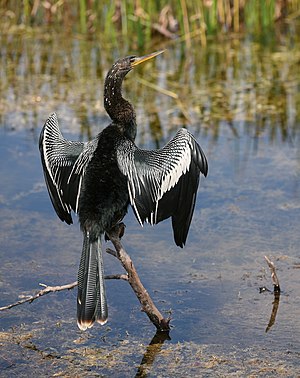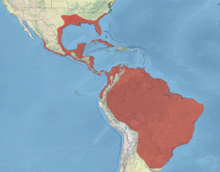American darter
| American darter | ||||||||||
|---|---|---|---|---|---|---|---|---|---|---|

American darter ♂ ( Anhinga anhinga ) |
||||||||||
| Systematics | ||||||||||
|
||||||||||
| Scientific name | ||||||||||
| Anhinga anhinga | ||||||||||
| ( Linnaeus , 1766) |
The American Anhinga ( Anhinga anhinga ) is a relatively common bird art from the order Suliformes . The kind comes in two subspecies on the American double continent from the southeast of the USA over Central America and Amazonia to the north of Argentina . The greatest similarity exists to the cormorants (Phalacrocoracidae).
Although the IUCN generally states a population decline for this species, it is not considered endangered due to its very large distribution area and the only gradual decline ( least concern ).
Appearance and vocalizations
When fully grown, the American darter reaches a body length of about 85 centimeters, a wing span of 1.4 meters on average and then weighs 1,350 grams. The beak is slender and pointed. It's about twice as long as the head. The bill and webbed feet are yellow. The American darter is a dark feathered fish eater with a very long neck. He often swims in such a way that only his neck and head are visible above the water. Females differ from males by their gray-brown neck and head. Young birds resemble the females, but are generally duller in color.
American darter make only a few vocalizations. The occasional click of beak can be heard from rearing American darters .
The wings of the American darter are wide and enable powerful and encouraging wing beats, which alternate with longer gliding phases. The long tail is fanned out in flight, which has led to the name water turkey (" water turkey ") in the USA .
The legs start far behind the body. All four toes are connected with wide webbed feet. In the countryside, they tend to move awkwardly, spreading their wings to keep their balance. In the water they move like cormorants: when swimming with alternately paddling feet, when diving with simultaneous and parallel driving feet, with the wings almost completely laid out. Dives last 30 to 60 seconds.
It can be confused with the shagfish , the only species of cormorant in North America that has a similar body size and color. However, the two species can be distinguished by their tails and beaks. The tail of the American darter is wider and significantly longer than that of the ear shag. The American beak is pointed while the ear-shag beak is hook-shaped.
distribution
The American darter lives in the warmer regions of North and South America .
During the breeding season it can be found in tree-lined swamps, on lakes, on slow-flowing rivers and in mangroves. Florida, Louisiana, and southeast Georgia have the highest population densities in the United States. American darter originally bred in a region that included the US states of Oklahoma, Illinois, Missouri, Missouri, and Kentucky. In North America, the most northern members of this species are migratory birds. They leave their breeding grounds in October and return in March. The greatest concentrations of American darter in the United States are found in Florida during the winter months.
As random visitors , they are observed far outside their normal range. American darter have been observed in the US states of Pennsylvania and Wisconsin .
Way of life
The plumage of the darter is not waterproof due to oils, as is the case with ducks . It can get so wet that he can hardly swim and has problems getting up in the air. However, this plumage also allows it to dive very well and to hunt for fish underwater. After the hunt, the American darter, similar to the cormorant, dries up by sitting in the sun with its wings outstretched. This bird species can often be seen hunting for fish together with other representatives of its species.
Subspecies
There are two subspecies:
- The nominate form A. a. anhinga lives east of the Andes in South America and is also found on the islands of Trinidad and Tobago . It is the larger of the two subspecies.
- A. a. leucogaster is found in the southeastern United States, Mexico, Cuba, and Grenada .
literature
- Jonathan Alderfer (Ed.): Complete Birds of North America , National Geographic, Washington DC 2006, ISBN 0-7922-4175-4 .
- David Allen Sibley : The Sibley Field Guide to Birds of Eastern North America . Alfred A. Knopf, New York 2003, ISBN 0-679-45120-X , p. 45.
Web links
- Anhinga anhinga in the Red List of Threatened Species of the IUCN 2008. Posted by: BirdLife International, 2008. Accessed on December 19 of 2008.
- Videos, photos and sound recordings of Anhinga anhinga in the Internet Bird Collection
Single receipts
- ↑ BirdLife entry for American Darter , accessed May 14, 2015
- ^ David Allen Sibley : The Sibley Field Guide to Birds of Eastern North America . Alfred A. Knopf, New York 2003, ISBN 0-679-45120-X , p. 45.
- ↑ David S. Maehr, HW Kale, Herbert W. Kale, II: Florida's Birds: A Field Guide and Reference . Pineapple Press Inc, 2005, ISBN 1-56164-335-1 , pp. 33, 38.
- ↑ a b c Jonathan Alderfer (Ed.): Complete Birds of North America , National Geographic, Washington DC 2006, ISBN 0-7922-4175-4 . P. 108
- ^ Roger Tory Peterson : A Field Guide to the Birds of Texas . Houghton Mifflin Harcourt, 1998, ISBN 0-395-92138-4 , p. 130.
- ↑ Gerald M. McWilliams, Daniel W. Brauning: Birds of Pennsylvania . Cornell University Press, 1999, ISBN 978-0-8014-3643-7 , p. 43.
- ^ Samuel D. Robbins: Wisconsin Birdlife: Population and Distribution Past and Present . University of Wisconsin Press, 1991, ISBN 978-0-299-10260-9 , pp. 127-128.
- ^ A b Emmet Reid Blake: Birds of Mexico: a guide for field identification . University of Chicago Press, 1953, ISBN 0-226-05641-4 , pp. 151-152.




